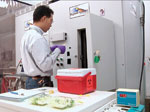
Visiting researcher Sanghyup Jeong loads samples of lettuce into a prototype X-ray device at Michigan State.
A Purdue University researcher has devised a method that comprises a set of high-voltage coils that generate a plasma field inside a package, creating ozone inside the package that kills bacteria.
Kevin Keener, an associate professor of food science, says his method uses only up to 40 watts of electricity and raises the temperature inside the package by only a few degrees. It has been tested on spinach and tomatoes, but could conceivably be used on any food in almost any kind of container, Keener says.
Another method involving electricity was introduced by researchers from Germany’s Fraunhofer Institute for Process Engineering and Packaging at the recent Anuga FoodTec show in Cologne. This method entails putting a food package in de-ionized water, then running radio frequency waves through it to induce heat. The water conducts the energy better than air, allowing faster, more even heating with less power.
The packaging material could be solid like glass, or flexible like plastic film. The only requirements are that it be water-tight and transparent for the radio waves. The German team achieved the best results for solid blocks of food, like tofu or sausage, or jars with liquid or semi-liquid product.
Lastly, at Michigan State, a team of researchers is studying an X-ray system for food irradiation. The system would use less irradiation than existing systems based on electron beams or gamma rays, which can change the taste of products, especially fat-rich foods like oils or nuts. The Michigan State researchers say they have shown that X-ray systems can kill pathogens like E.coli on ground beef, leafy greens and nuts.
The disadvantage of X-ray irradiation is that it can only treat single packages, as opposed to electron-beam or gamma systems, which can irradiate entire pallet loads. A big advantage is that X-ray units can be operated by food packagers inside their facilities, unlike gamma rays or e-beams, which require food to be shipped to central irradiation facilities.
Rayfresh Foods Inc., Ann Arbor, Mich., provided MSU with a prototype machine. The New York Times reported that Rayfresh recently landed a contract to build an X-ray machine to treat ground beef for Omaha Steaks.
Rayfresh Foods Inc.
734-222-1700;www.rayfreshfoods.com
